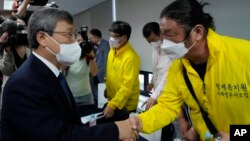South Korea’s Truth and Reconciliation Commission has found the country’s past military governments responsible for atrocities committed at Brothers Home, a state-funded vagrants’ facility where thousands were enslaved and abused from the 1960s to 1980s.
The commission on Wednesday announced the initial results from its investigation into human rights violations at Brothers, including extreme cases of forced labor, violence and deaths.
The commission said it has so far confirmed 657 deaths at Brothers, which was higher than the previously known tally of 513 between 1975 and 1986 documented in the facility’s records.
It also found that police in the southern city of Busan, where the facility was located, randomly grabbed people off the streets to send them to Brothers, regardless of whether they had easily identifiable homes or families, and often allowed Brothers employees moving in trucks to do the kidnapping themselves.
The commission also said it found that Brothers, run by late owner Park In-keun and his family, embezzled the wages of thousands of inmates who were forced into slave labor.
So far, no one has been held accountable for hundreds of deaths, rapes and beatings at Brothers.
Jung Geun-sik, the commission’s chairperson, said its findings were based on its investigation into the cases of 191 individuals, who were among 544 Brothers survivors who have so far filed applications. Jung said the commission also plans to look into the foreign adoptions of Brothers children as it continues its investigation.
From the 1960s to 1980s, South Korean military dictators ordered roundups to beautify the streets. Thousands — including homeless and disabled people, as well as children — were snatched off the streets and brought to facilities where they were detained and forced to work.
In interviews with dozens of former Brothers inmates, many said that as children, they were brought to the facility after police officers kidnapped them, and that their parents had no idea of their whereabouts.
The drive intensified as South Korea began preparing to bid for and host the 1988 Summer Olympics. Brothers, a mountainside compound in the southern port city of Busan, was the largest of these facilities and had around 4,000 inmates when its horrors were exposed in 1987.
Kim Yong Won, the former prosecutor who exposed Brothers, told The Associated Press that high-ranking officials blocked his investigation under direction from the office of military strongman Chun Doo-hwan, who feared an embarrassing international incident on the eve of the Olympics.
The commission began investigating the Brothers abuse in May last year, following a years-long struggle for redemption by Brothers survivors, many of whom who are struggling with financial and health problems.








